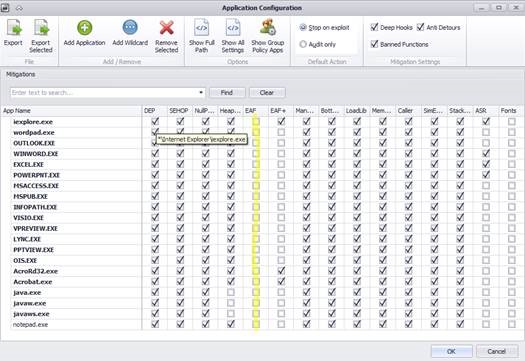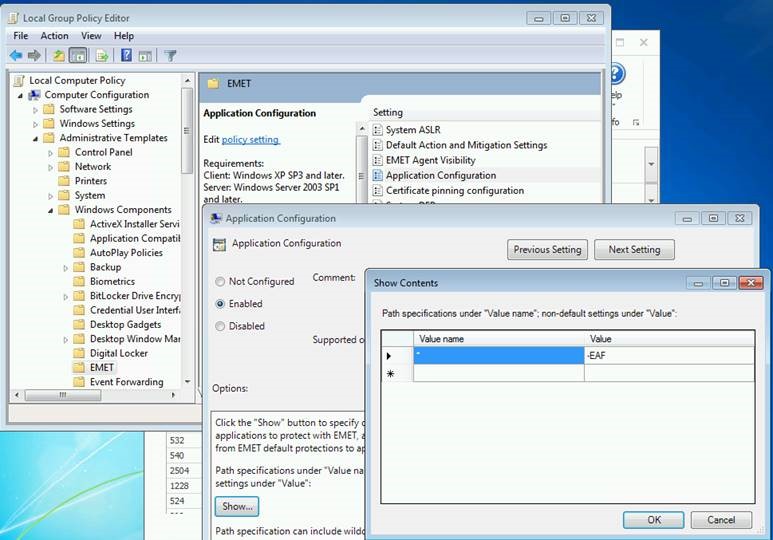The September 2016 update rollup includes some new improvements and fixes for the Windows 7 Service Pack 1 (SP1) and Windows Server 2008 R2 SP1 platform. We recommend that you apply this update rollup as part of your regular maintenance routines.
Improvements and fixes
To learn more about the non-security improvements and fixes in this update, see the "September 20, 2016 – KB3185278" section in Windows 7 SP1 and Windows Server 2008 R2 SP1 update history.
Known issues in this update
Symptoms
Assume that you are running Enhanced Mitigation Experience Toolkit (EMET) on Windows 7 Service Pack 1 (SP1) on a computer on which update 3175024 is installed. When you try to start an application, the application freezes very early in the process and does not completely start.
Cause
This issue occurs because the Export Address table Filtering (EAF) mitigation is active on the application.
Workaround
To work around this issue, use one of the following methods to disable the EAF mitigation on all applications.
Method 1
Select a running process in EMET, press and hold (or right-click) Configure Process, and then clear the EAF check box on each running application. The following screen shots show these steps.


How to get this update
Important If you install a language pack after you install this update, you must reinstall this update. Therefore, we recommend that you install any language packs that you need before you install this update. For more information, see Add language packs to Windows.
Method 1: Windows Update
This update is provided as an Optional update on Windows Update. For more information about how to run Windows Update, see How to get an update through Windows Update.
Method 2: Microsoft Update Catalog
To get the stand-alone package for this update, go to the Microsoft Update Catalog website. Note You must be running Microsoft Internet Explorer 6 or later versions.
Method 3: Microsoft Download Center
The following files are available for download from the Microsoft Download Center.
|
Operating system |
Update |
|---|---|
|
All supported x86-based versions of Windows 7 |
|
|
All supported x64-based versions of Windows 7 |
|
|
All supported x64-based versions of Windows Server 2008 R2 |
|
|
All supported IA-64-based versions of Windows Server 2008 R2 |
For more information about how to download Microsoft support files, click the following article number to view the article in the Microsoft Knowledge Base:
119591 How to obtain Microsoft support files from online services Microsoft scanned this file for viruses. Microsoft used the most current virus-detection software that was available on the date that the file was posted. The file is stored on security-enhanced servers that help prevent any unauthorized changes to the file.
Update detail information
Prerequisites
To apply this update, you must install Service Pack 1 for Windows 7 or Windows Server 2008 R2.
Restart information
You must restart the computer after you apply this update.
Update replacement information
This update doesn't replace any previously released update.
File Information
|
File name |
SHA1 hash |
SHA256 hash |
|---|---|---|
|
Windows6.1-KB3185278-ia64.msu |
8FD16B5A0C0F1D662D4F98D02C35FA4AAB12F1C3 |
23050937852FF8DC13E1B9A82ECD75E6D36CFD89A7251292496A4737A0D249D6 |
|
Windows6.1-KB3185278-x86.msu |
FC7486C27ED70826DCCEFEB2196FC8BB19FC8DF5 |
44D951DD968126E13DCB90BE7C9BC5C0A3E9DF81BB9F0D363C33C9D63A0DE87B |
|
Windows6.1-KB3185278-x64.msu |
8134EC9D31DC04F4F47F832016A0A3F4B17E610B |
20989A96AEC89062FADC67935DEC7197A53804767073BA2571461B3929E56E7F |
File informationFor a list of the files that are provided in this update, download the file information for update rollup 3185278.
References
For more information about Windows Update, go to the following Microsoft websites:
Troubleshoot problems with installing updates
Updates: frequently asked questions
KB2509997 You can't install updates in Windows Vista, Windows 7, Windows Server 2008, or Windows Server 2008 R2Learn about the terminology that Microsoft uses to describe software updates.










